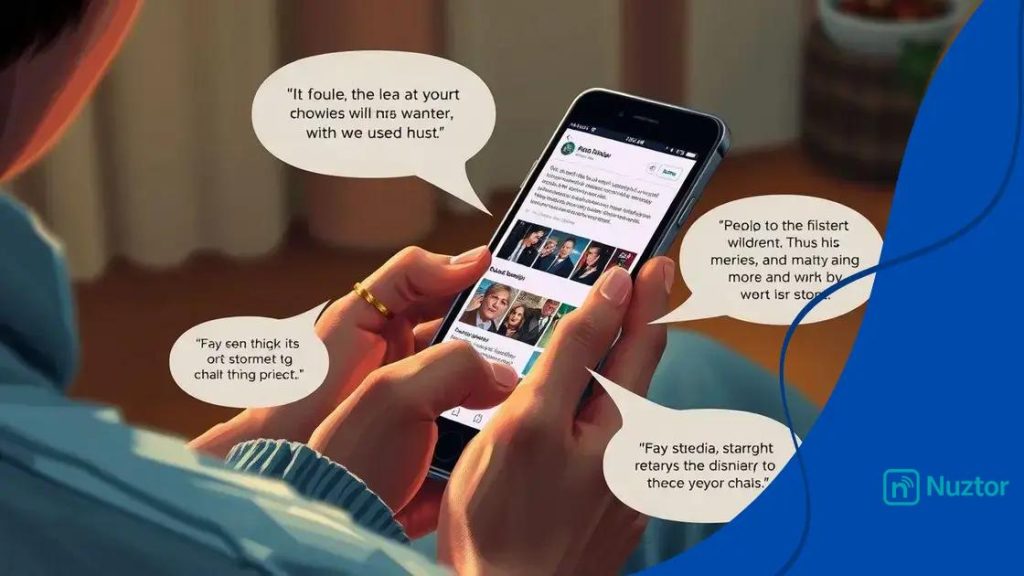News on disinformation across social media

Disinformation on social media impacts public perception by distorting facts, shaping opinions, and triggering emotional responses, making it crucial to verify information before sharing.
News on disinformation across social media is more relevant than ever. As we scroll through our feeds, it’s crucial to recognize the influence of false narratives on our understanding of the world. Have you ever questioned whether the news you read is real?
Understanding disinformation on social media
Understanding disinformation on social media is essential in today’s digital landscape. Social media platforms serve as powerful communication tools, but they are also breeding grounds for false information. Why is it important to recognize what is real and what is not? A clear comprehension can help us navigate our online interactions and make better decisions.
What Is Disinformation?
Disinformation refers to false information that is deliberately spread to deceive people. It can take many forms, including articles, images, or even videos. Recognizing disinformation requires critical thinking and a careful examination of sources.
How It Spreads
Disinformation spreads rapidly on social media thanks to the viral nature of these platforms. But what drives this phenomenon? Here are some key factors:
- Emotional appeal: Content that provokes strong emotions often gets shared more.
- Algorithms: Social media algorithms can amplify disinformation by promoting popular content regardless of its accuracy.
- Insider influence: Individuals with a large following can inadvertently spread lies.
Furthermore, disinformation often exploits existing social tensions or fears. This can make it particularly persuasive and difficult to counter. As consumers of online content, we must be vigilant.
When engaging with content online, ask yourself critical questions. Is the source credible? Are there supporting details? Remember, informed users are less likely to fall victim to disinformation. By understanding the dynamics of social media, we can better protect ourselves from deceitful content and share trustworthy information.
The role of algorithms in spreading false information
The role of algorithms in spreading false information is significant and often overlooked. These complex systems determine what content we see on social media, shaping our perceptions and influencing our decisions without us realizing it. How do these algorithms work and why should you care?
How Algorithms Function
Social media platforms use algorithms to curate content based on user behavior. For instance, if you frequently engage with certain types of posts, the algorithm is likely to show you more of that content. This can create an echo chamber where false information thrives, as users are continuously exposed to the same misleading narratives.
Factors Contributing to Disinformation Spread
Several factors in algorithm design contribute to the spread of disinformation. Here are a few:
- Engagement Metrics: Content that generates high engagement can be promoted further, regardless of its accuracy.
- User Interactions: If many people share or like a post, it signals the algorithm to show it to even more users.
- Trending Topics: Algorithms may prioritize content that is currently trending, which can sometimes include misleading information.
With algorithms focusing on engagement, they often overlook the accuracy of information. This can lead to disinformation spreading like wildfire across platforms. As users, we must remain vigilant and question what we see.
It’s crucial to understand that algorithms are not inherently good or bad; they are tools that can amplify certain content. By grasping how these systems work, we can better navigate our digital environment and critically assess the information presented to us.
How to verify news sources online

Verifying news sources online is a vital skill in today’s information-rich world. With so much content available, how can we ensure that what we read is accurate? This process is crucial for preventing the spread of disinformation and making informed opinions.
Key Steps to Verify News Sources
To effectively validate news, follow these essential steps:
- Check the Source: Ensure the website or organization is reputable. Look for established news outlets with a history of credible reporting.
- Read Beyond the Headline: Sometimes, headlines can be misleading. Always read the full article to understand the context.
- Look for Supporting Sources: Verify if other reputable sites are reporting the same story. Multiple sources can confirm the accuracy of the information.
Moreover, pay close attention to the author. Well-known journalists or experts in the field lend credibility to the article. If information comes from an anonymous source, be cautious.
Another helpful approach is to consider the article’s date. Old news can resurface and create confusion if presented as current events. Ensure the information you’re reading is up-to-date to avoid misunderstandings.
Lastly, using fact-checking websites can assist in verifying claims. Platforms like Snopes or FactCheck.org provide valuable insights into various topics, helping users discern fact from fiction. By adopting these strategies, you empower yourself to combat disinformation effectively, enhancing your online literacy.
The impact of disinformation on public perception
The impact of disinformation on public perception is profound and far-reaching. It shapes opinions, influences behaviors, and even sways elections. When people encounter false information, it can alter their understanding of reality.
Shaping Opinions
Disinformation can distort the truth and lead people to form opinions based on incomplete or false data. When such information circulates widely, it creates narratives that can overshadow factual reporting. This distortion can change how communities view vital issues, from health crises to political matters.
Emotional Responses
False information often evokes strong emotional reactions. It can trigger fear, anger, and confusion, leading people to make decisions based on exaggerated claims. Here are a few emotional triggers commonly exploited:
- Fear: Disinformation often amplifies fears about safety, health, or social stability.
- Outrage: By sensationalizing stories, disinformation can provoke outrage, steering public discourse dramatically.
- Connection: Disinformation can create a false sense of community through shared misinformation.
As emotions rise, rational thinking can decline. This makes it challenging for individuals to sift through the noise and find credible information. Furthermore, when emotions drive decisions, people may overlook the fact that they are being misinformed.
In addition, the echo chamber effect can solidify these distorted perceptions. When disinformation aligns with personal beliefs or biases, individuals are more likely to accept it as truth. This can create a feedback loop where misinformation is reinforced within like-minded communities, further distancing them from objective reality.
Strategies for combating disinformation
Combating disinformation requires a proactive approach. As misinformation continues to spread through social media and online channels, having effective strategies helps individuals and communities safeguard the truth. Understanding how to fight back is crucial for informed decision-making.
Critical Thinking Skills
One of the best defenses against disinformation is cultivating critical thinking skills. This allows individuals to analyze information carefully before accepting it as true. Here are some ways to enhance critical thinking:
- Question Sources: Always ask where the information is coming from. Is it a reliable source?
- Identify Bias: Look for potential biases in the content. Recognizing bias helps in assessing the information’s validity.
- Cross-Check Facts: Validate information against multiple sources to ensure its accuracy.
These practices empower individuals to make better-informed choices about the information they consume.
Encouraging Digital Literacy
Digital literacy education plays a vital role in combating disinformation. Teaching people how to evaluate online sources critically and recognize false information can significantly reduce the spread of lies. Schools and communities can promote digital literacy by offering workshops and resources that cover:
- Identifying Legitimate News Sources: Encourage using traditional media alongside new media.
- Understanding Algorithms: Educate about how algorithms influence our news feeds on social media.
- Sharing Best Practices: Promote strategies for verification and critical analysis of online content.
Additionally, individuals can play an active role in reporting disinformation when they encounter it. Many social media platforms have options for reporting false content. By doing so, users contribute to a healthier online environment.
Combating disinformation is a collective effort. As more people become aware of the tactics used by misleading sources, they can stand together against the spread of false information, promoting a more informed society.
FAQ – Questions about combating disinformation
What is disinformation?
Disinformation is false information that is intentionally spread to mislead people.
How can I verify news sources online?
You can verify news sources by checking their credibility, reading beyond the headlines, and cross-referencing with multiple outlets.
What role do algorithms play in spreading disinformation?
Algorithms prioritize content based on user engagement, which can inadvertently promote misleading information if it generates more clicks.
How can I help combat disinformation in my community?
You can educate others about identifying false information, participate in discussions, and report misleading content on social media platforms.